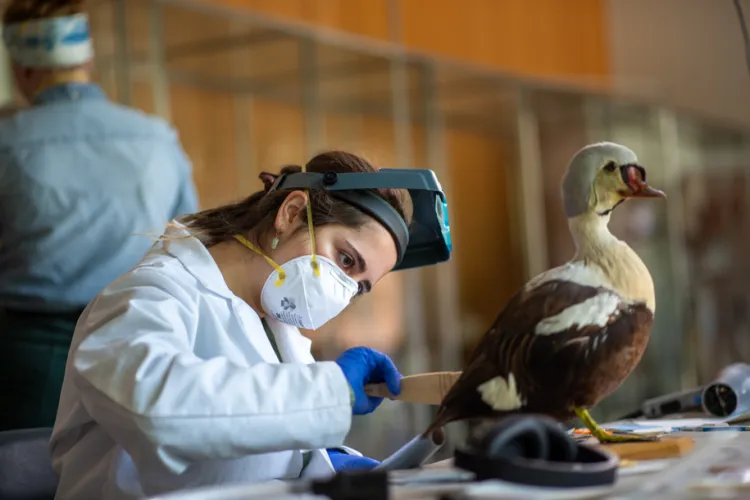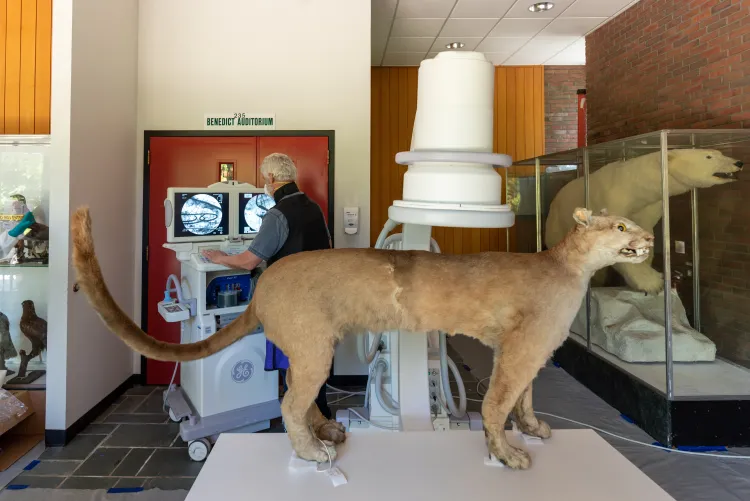Sophie Feldman ’22 quietly, gently reaches out with a soft brush and dabs the tail feathers of a magnificent duck. It sits perfectly still. In fact, it’s been sitting still for decades, collecting dust in the lobby of Benedict Auditorium on campus—one member of a remarkable, but neglected, taxidermy collection of stuffed birds and other creatures that extends back to at least the 1850s. The specimens include an extinct passenger pigeon, a poached Canadian polar bear seized at U.S. Customs in the 1970s, and a deceased mountain lion held by UVM since the nineteenth century.
Now their dust is getting dusted off.

“This is a king eider,” Feldman says. “We’re working our way through this entire cabinet, cleaning all these birds.” Feldman is spending a good chunk of this summer vacuuming feathers, reglueing feet, organizing rare eggs, and examining mounts under an x-ray machine—to bring this display, and other parts of the UVM Natural History Museum’s collection, back into better form.
The taxidermy restoration project has been co-led by UVM staffer Sonia DeYoung, a 2017 graduate of UVM’s Field Naturalist Program, who “fell in love” with the collection, she says. Collaborating with professors Michael Sundue, Walter Poleman, David Barrington, Bill Kilpatrick and others, she successfully applied to the Institute of Museum and Library Services for a restoration grant. Under the careful hands of conservator Lisa Goldberg and Shelburne Museum expert Nancie Ravenel, the animals have been getting examined, catalogued, cleaned and fixed. “This is a complex and important collection,” Goldberg says, “we’d like it be around for hundreds of years to come.” Along the way, the professionals have been training Feldman and her co-intern Sabi Ward ’24, an art history and museum studies major.
Both students aim for careers in museums. “I want to do art conservation,” Feldman says. “It takes a lot of time on internships and apprentice work before you can get into grad school. So this is where I'm starting. This is my first art conservation job.”
A few days later, Goldberg and the two students climb into one of the glass cabinets, pick up the collection’s semi-famous, slightly bedraggled and distinctly crazy-looking mountain lion. With gloves and great care, they ease the specimen under the beam of a portable x-ray machine, operated by UVM cardiology research technician Steve Bell. “I happen to love taxidermy too,” he says.
This cat has been an object of fascination to students for generations. “Those eyes are actually owl eyes—that's why it looks so freaky,” explains DeYoung. It’s also historically and scientifically important. Records show it was part of UVM collections at Torrey Hall before 1898, was moved to the Fleming Museum after it was built in 1931, was on display in Billings Library (wearing a beanie) in the 1950s, was moved to this location in Marsh Life Science building after 1968—and it may have been the last mountain lion (also known as a puma, panther, or, of course, a catamount!) killed by hunters in the Adirondacks.
“We have no idea what’s inside—and we want to know,” says Goldberg, who will work with another conservator next year to complete the restoration of this specimen. One foot, bound with wire, and a large tear in the fur are in obvious need of repair. “It’s had a hard life,” she says.

Over the next hour, the students follow instructions from Goldberg and Bell as they ease the animal back and forth under the x-rays. On the screen, they spot a wooden frame—“I’d call it a 2x4,” says Ward, “except that’s not historically appropriate”—and a broken wire. Plus they find some mysterious bones. “It has all of its toe bones and its skull, and those are doing things structurally,” says Ward, but they also spotted some other bones inside the mount “that mimic the narrowing of human finger bones, which suggests they might come from the end of the tail. It’s kind of a mystery.”
It will take the full restoration to unravel the tale further, but in the meantime Ward and Goldberg gather some bits of fur to send to a scientist at Middlebury College who is doing DNA work on mammals. In this era of fast-changing ecosystems and declining biodiversity, there is a growing recognition that natural history collections provide an irreplaceable record of the past by which to understand the present. In 2018, the U.S. Fish and Wildlife Service declared mountain lions officially extirpated from northeastern United States. “This is an extinct animal,” Lisa Goldberg says, gently resting her blue glove on the faded tawny fur. Asked what she finds most gratifying about doing taxidermy restoration, she thinks for moment. “Bringing things back to life,” she says.